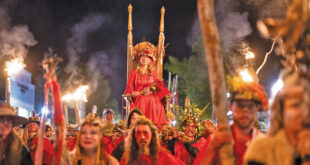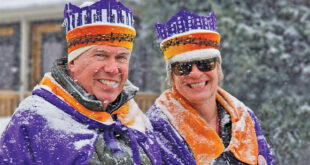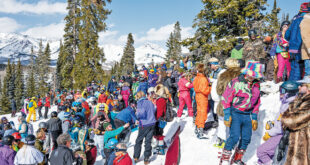Vinotok’s Liar’s Night is fun by itself, but the excitement is building because we’re getting really close now to burning that Grump (after a fair trial, of course) and alleviating an entire town’s woes.
It’s time for the Green Man to rise, maidens to frolic, the community to come together and stories to be told. Thursday, September 18 at 8 p.m. is the Annual Botzie Spritzer Memorial Liar’s Contest, named after one of Crested Butte’s notorious old timers and grand story tellers. With his accordion and his infectious smile, Botzie could weave a tale that locals would never tire of hearing.
The Mother of Vinotok, Marcie Telander, recalls Botzie’s tall tales and says, “Botzie was known as the greatest sports tall tale teller. He was a rabid fishermen from childhood on and he was renowned for how long he could stretch the tail of the fish he had just caught.” Telander says he would greet both women and men with a spunky, “Hi Captain!” Culturally, Botzie was the king of whoppers in Crested Butte and would win hands-down in the Liar’s Contest. “Botzie wasn’t very tall and he would stand on the bar and regale the crowd with his story and people were mesmerized. He always began with ‘Well Captain, here’s how it was…’ The Spritzer clan was a very special family in Crested Butte.”
Liar’s night started 28 years ago because Botzie said, “You can’t just have people telling these stories without having a liar’s contest.” He and another local, Wes Light, helped cook up some of the first stories.
One of the early classics and one of the early winners, circa 1989 at the Wooden Nickel, was Nick Rader who wore one of those goofy Canadian plaid hats with the ear flaps and big bill. This was the lie he won with: “I understand women.” The place fell into hysterical laughter.
Telander notes that one of the very best parts, and one of the traditions, was stories about organizations or individuals. “These are the stories, the political commentaries told in the form of a tall tale. It’s also a Crested Butte tradition. People wouldn’t talk about other people, speak their names in a derogatory way… it was too small of a town and they were too dignified. A lot of the stories would be about the big wigs of the mining company Colorado Fuel and Iron. These stories would ripple on down through the bars and saloons and the locals could tell these jokes around the big wigs without getting in trouble. They could create a story and everybody knew who they were talking about but it could never be identified as libel or slander or a negative comment about anyone in particular.
“Back in the old days, everyone was expected to bring a story to social gatherings, it was like their instrument,” Telander says. “These were long stories, Botzie stalking the wild trout or the monster kokanee.” She remembers him telling his fish tale, stretching his arms as wide as they could reach with his proclivity to keep an audience captivated back in the days when tall tales could be entertaining without being dumbed down or sleazy.
Trying to reclaim this art of storytelling is what Vinotok was built on. “The elders and I wanted to bring together the new folks and the town originals even though we seemed to be politically split on our views of extractive mining,” Telander says, explaining that there was a big rift in the community between the old timers and the newcomers in those days since, for the original families, mining had been their lives and livelihood from the time they were teenagers.
However, the kind of mining that they did was completely different from the molybdenum mine being proposed in the 1970s on Red Lady. That technology, which still threatens Red Lady Mountain, can remove the top of the mountain and then allow it to collapse, Telander feels.
Marcie tells of her quest back then to connect the past and present with the future. “When I was gathering the stories of the elders at Tony’s Conoco and at Two Buttes Senior Center, they talked about this feeling of separation and that’s when we started looking at what could bring us together. I asked them if they didn’t think that their personal stories and life experiences would be one of the ways that they could share with the new people. We realized that personal stories are something we all have and they are the harvest we can truly share. So that’s how it came to be a harvest festival. The harvest itself was the stories and the children. We didn’t have all these organic farms, except for hay, and so Vinotok started with a week of storytelling from the miners, ranchers and old timers.”
It started at the Mallardi Theatre, and Telander led storytelling workshops so that the new folks could learn to tell their stories. “There would be at least seven performances throughout the week and they became very popular, but the old timers were so shy and it took five years to talk them into getting onstage and telling their stories. It was one thing for them to tell it at Tony’s or on the ‘liar’s bench’ in front of the post office but it’s different when there are lights and an audience and applause. It was the greatest act of generosity for these people to share their stories and through both the elders and the new timers being willing to take the risk and share their personal stories, we discovered that we had a great deal in common.”
The Grump has been around since ancient times in one form or another and, surprisingly, the old timers had a Grump burning this time of the year way back in the mining days of Crested Butte. The local practice hails back to the miners’ old country, Croatia and Slovenia, and the tradition was brought over when they immigrated. The Grump procession of those early Buttians probably included torches, accordion music and homemade wine, newly uncorked with a mandate to drink it all so they could lay down the new wine. The modern Vinotok’s name was derived from that wine tradition, which means “fall wine festival” or more literally in translation in the Slavic countries, the time of year that we bring in the grapes.
“The Grump came into being while sitting around the table with Johnny and Frances Somrak who were having potica bread and homemade zinfandel wine at this time of year,” explains Telander, “and they started talking about the tradition of the effigy, which, on a yearly basis the miners and townspeople would create.” This effigy was usually designed to represent a bigwig from the Colorado Fuel & Iron Company (CFI), which owned the company store and the mines.
The stories of the old timers conveyed that the conditions in the mines were pretty terrible. Many spent their entire lives in the black-dusted underground depths starting around age 14. “So building this effigy was one of the only ways they could get a little of their own back,” Marcie says, “to make a strong political statement to drive home a point. The effigy was meant to look like a specific boss and they would even pin the guy’s name or nickname on the chest of this effigy.”
The town’s people didn’t just have a trial for this Grump, they marched it right to the front of the house of the bigwig and ceremoniously hanged it—and then they burned it. “They were real determined to make their point,” Marcie says emphatically. “It was the only time they felt they were untouchable as a people. They wanted this thing dead.”
And what about the Grump? If he could tell his tale, what would it be? “I think it would have to be very similar to the Crested Butte version of a Greek comedy,” Telander smiles, “because in Greek comedy there is always the dark side. There can’t be a light side unless there’s a dark side and because of that there’s almost always redemption in Greek comedy. Of course, that’s what the Grump provides for us—he may carry the dark side for all of us but in his sacrifice it beckons the bright side.
“We have a living myth and that myth is formed from the most ancient stories from our elders’ backgrounds and our own cultural ancestral roots and this myth is acted out every day through out the fabric of Vinotok. It’s an ancient story that comes to life with the embodiment of these rich, vital and colorful characters who have held a great deal of meaning since the beginning of time. So now, not only are the stories told, they are lived. And everyone in the community can experience themselves living that myth, which for us is earth-honoring and has a great deal of respect for those elders who founded this community and came before us,” Telander says. “People are always asking what is the story acted out at the trial, what is story of the relationship? It’s the inter-connectiveness of relationships between nature and human.”
So, come to the Botzie Spritzer Memorial Liar’s Contest prepared with your exaggeration, whether it’s about your alien abduction or being abandoned on the convent steps and raised by nuns or living out your wild fantasies in an irrigation ditch with a bottle of rye and a beat up guitar after you flunked out of WSCU. Regardless of your tale, take care not to bore or annoy the Liar’s Night Wench and the Gong Maiden or you’ll be tossed out to the famished wolves of winter. You’ll have just five minutes to amuse the crowd and judges and if you succeed, it will get you a mighty fine prize donated by local businesses. Bonus points for costuming up.
And let it be known, if you’re an exceptionally, exquisitely and unequivocally single man, a truly authentic and contemporary male who also embodies ancient traditions and primordial man, a “gentle man” with boundless energy for women and a true son of Mother Nature, and of course, very kissable, then you could be the next Green Man, to be announced at Liar’s Night.
Check Also
Closing day celebrations
Spirits were bittersweet at the Crested Butte Mountain Resort as crowds gathered on the last …
 The Crested Butte News Serving the Gunnison Valley since 1999
The Crested Butte News Serving the Gunnison Valley since 1999




